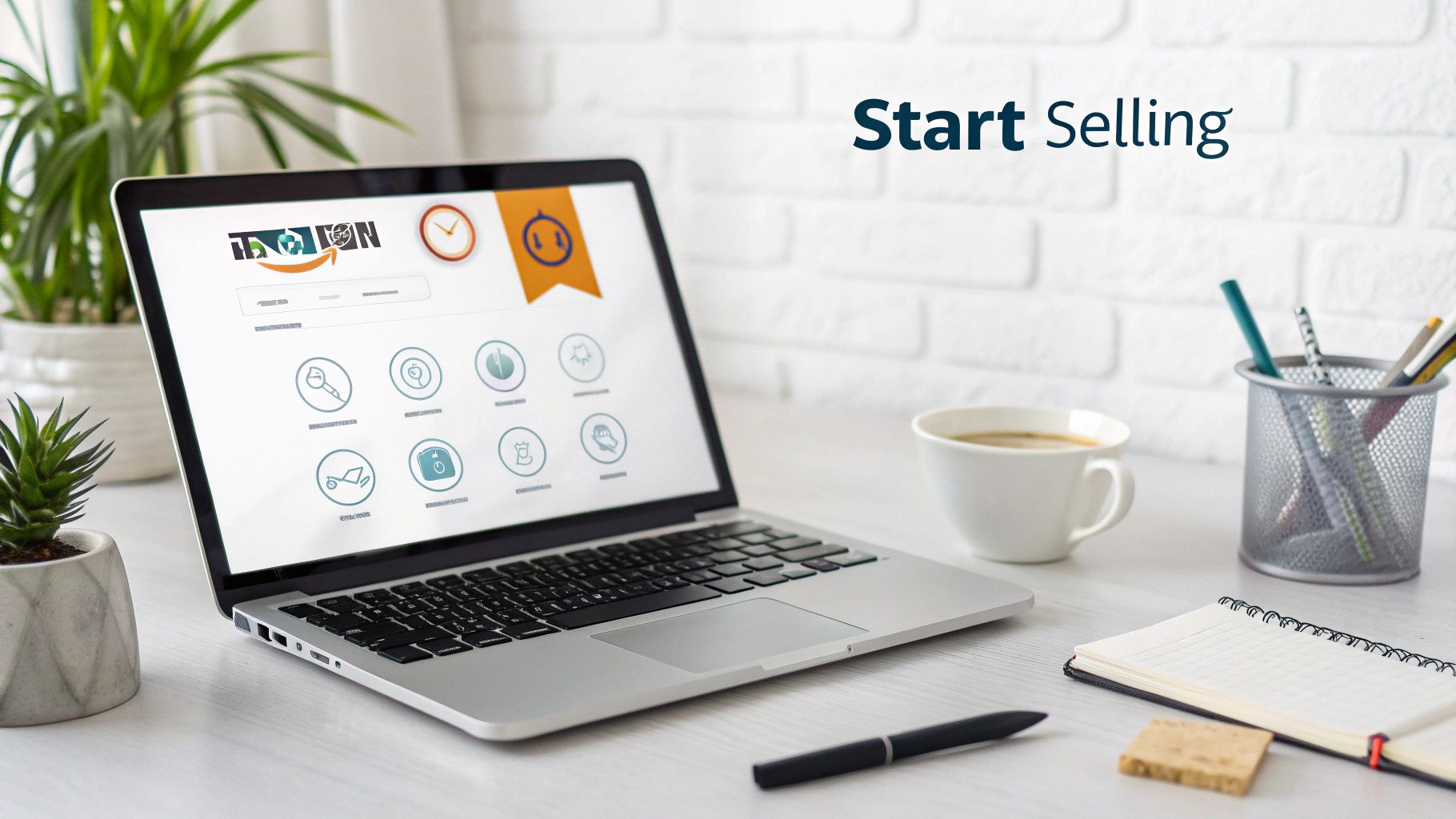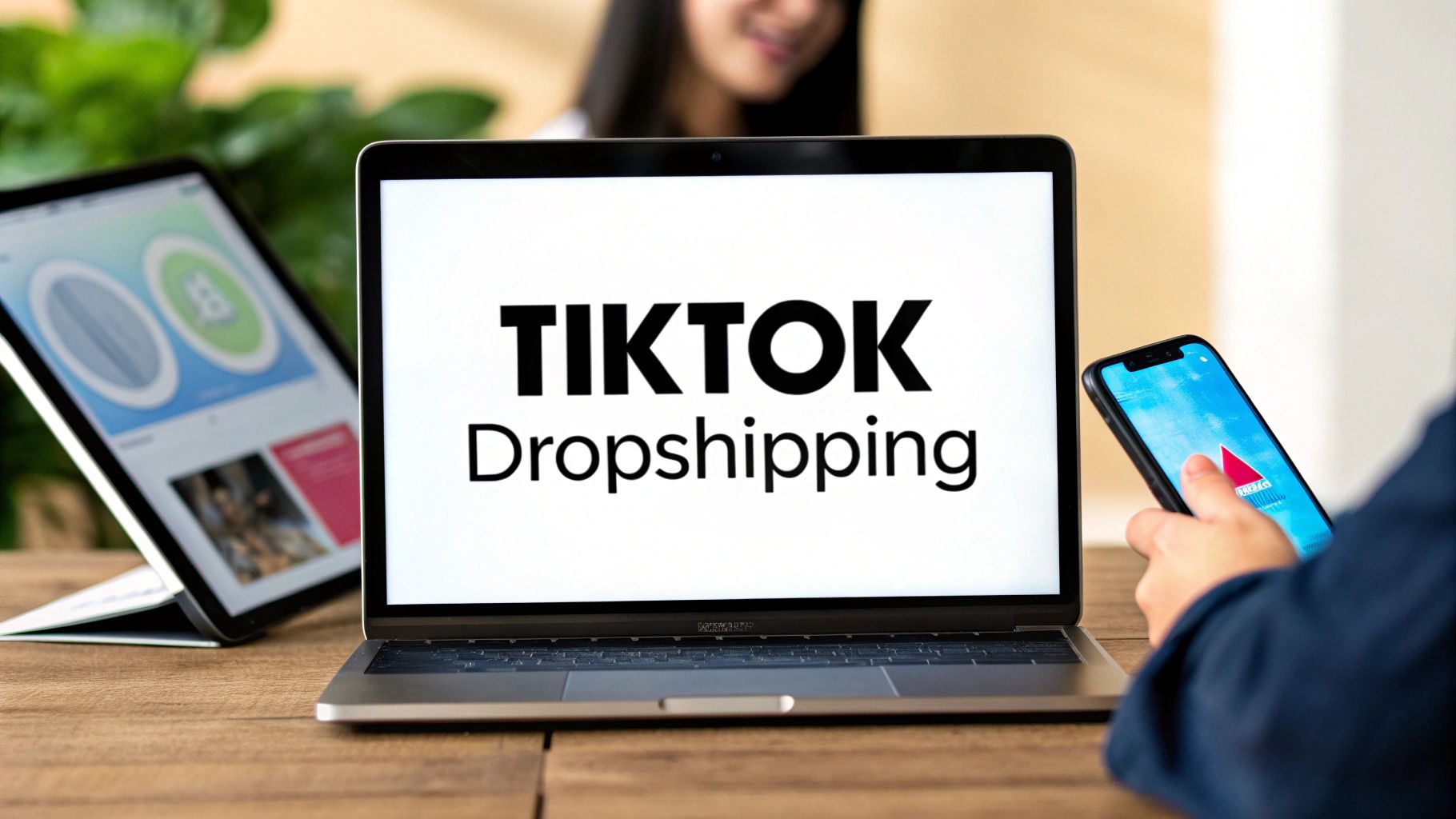Sell Digital Products on Amazon: Expert Tips
April 2, 2025

Breaking Into the Digital Gold Rush on Amazon

Selling digital products on Amazon is incredibly appealing. No inventory, low overhead, and the potential for passive income: it's a compelling combination. This section explores how you can take advantage of this digital goldmine. We'll look at the most successful digital product categories and the benefits Amazon offers sellers. We’ll also discuss how to evaluate your product's suitability for Amazon and navigate the platform requirements.
Unearthing the Digital Treasures: What Sells?
Several digital product categories perform exceptionally well on Amazon. E-books, for instance, remain a cornerstone of the digital marketplace. Amazon's Kindle Direct Publishing (KDP) program makes self-publishing easy, providing access to a vast potential audience.
Another popular category is printables. These include planners, journals, and activity sheets, offering customers immediate value and catering to specific niches.
Online courses and educational materials are also experiencing a surge in popularity. From short tutorials to comprehensive professional development programs, these products tap into the growing demand for online learning.
The Amazon Advantage: Why Sell Digital Products Here?
Why should you sell on Amazon instead of another platform? One major reason is Amazon's massive customer base. Millions of shoppers already use the platform, making it easier to reach your target audience without significant investment in external marketing.
Amazon is one of the most visited e-commerce sites, boasting over 2.2 billion combined desktop and mobile visits in February 2022. While data specifically for digital product sales on Amazon is not readily available, the broader digital product market is booming. The volume of digital product transactions has grown by almost 70% over the last two years. This growth highlights the opportunity for selling digital goods on Amazon and similar platforms. For more detailed Amazon statistics, check out this resource: https://www.amraandelma.com/amazon-marketing-statistics/
Amazon’s established reputation and secure checkout process also instill confidence in customers. This trust often leads to higher conversion rates compared to independent platforms. Additionally, Amazon equips sellers with valuable tools and resources, including marketing and promotional options, streamlining the process of selling digital products.
Is Amazon Right for Your Digital Product?
Before you start selling, determine if your digital product fits Amazon’s audience and platform requirements. Here are some factors to consider:
- Demand: Is there a clear need for your product on Amazon? Research similar offerings and review customer feedback to understand existing demand.
- Competition: How competitive is your product's niche? A saturated market might require more aggressive marketing.
- Pricing: Can you price your product competitively and maintain profitability? Analyze competitor pricing and factor in your production costs.
- Uniqueness: What distinguishes your product from others? Highlighting your unique selling proposition is key to standing out.
This careful assessment helps ensure your product resonates with Amazon's audience and has the potential for success. It's also important to set realistic expectations for the first 90 days. Building a thriving digital product business on Amazon takes time and effort. Concentrate on creating high-quality product listings, accumulating positive reviews, and adapting your marketing strategy based on performance data. With dedication and perseverance, you can capitalize on the enormous potential of selling digital products on Amazon.
Crafting Digital Listings That Actually Convert

Creating compelling product listings is essential for turning potential customers into buyers, especially for digital products on Amazon. Selling intangible goods requires a unique approach. This section explores crafting digital listings that truly convert. We'll cover optimizing titles, using visuals, writing benefit-driven descriptions, and leveraging Amazon's special features.
Optimizing Titles for Algorithms and Humans
Your product title is the first thing potential customers see. It needs to grab their attention and include relevant keywords for better search visibility. Think of it as a mini-advertisement that immediately communicates value. Focus on clarity and keywords related to selling digital products on Amazon. Highlight the core benefit.
For example, instead of "Photography Guide," use a more descriptive title like "Photography Guide: Master Landscape Photography in Weeks – Digital Download." This is keyword-rich and appealing to both search engines and potential buyers.
Showcasing Intangible Products Visually
Visuals are key, even for digital products. Use mockups, graphics, or short video previews to give customers a tangible idea of what they're getting. For instance, if you’re selling a printable planner, show a few sample pages.
This helps customers visualize the layout and features. Visuals bridge the gap between the intangible nature of digital products and the customer’s desire to "see" what they are buying.
Writing Benefit-Driven Descriptions
Product descriptions should go beyond listing features. Concentrate on the benefits customers will experience. Instead of "50-page eBook," explain how it will "transform your cooking skills" and help them "create restaurant-quality meals at home."
Address any potential hesitations and emphasize the value. Highlighting benefits creates a stronger emotional connection with the product.
Leveraging Amazon’s Category-Specific Features
Amazon provides category-specific features that often get overlooked. If selling an e-book through Kindle Direct Publishing (KDP), use the "Look Inside" feature to let potential customers preview the content.
These features enhance the customer experience and encourage purchases. They build trust and demonstrate transparency. Consider Amazon’s scale. In 2023, third-party sellers in the U.S. sold more than 4.5 billion items, about 8,600 items per minute.
This demonstrates Amazon's massive sales potential, a benefit that extends to digital products as well. Find more detailed statistics here.
Strategic Pricing and Irresistible Offers
Pricing your digital products strategically is essential for maximizing revenue. Research competitor pricing while considering your product's unique value. Experiment with different pricing tiers.
You can also bundle multiple products together for greater value and encourage higher average order values. Limited-time promotions or discounts can create a sense of urgency. This can lead to more impulse purchases. By focusing on these elements, you can turn your Amazon digital listings into powerful conversion tools.
Amazon KDP vs. Alternative Digital Marketplaces

So, you’re ready to sell digital products on Amazon. But should Amazon be the only platform for your digital goods? This section compares Amazon's digital selling options, specifically Kindle Direct Publishing (KDP), with other popular choices like Etsy, Gumroad, and independent online stores. We'll explore the costs, audience reach, and the level of control you have on each.
Weighing Your Options: A Platform Overview
Choosing the right platform depends on your product, target audience, and overall business goals. Amazon offers a huge reach and a built-in customer base. However, selling on Amazon means fees and adhering to specific listing requirements. Think about how you'll need to present your products when deciding between Amazon KDP and other platforms. A good starting point for Amazon listings is learning how to write effective product descriptions. Check out these helpful tips on how to write a product description on Amazon.
Alternative marketplaces like Etsy attract a different kind of customer, often one looking for handmade or unique items. Platforms like Gumroad give you greater control over pricing and branding but require more effort on your part to market your products. Creating your own Shopify website offers the most control but requires building an audience from the ground up. If you're considering this route, you might find this guide useful: How to master selling on Instagram with Shopify.
KDP: Deep Dive into Amazon's Ebook Powerhouse
Amazon KDP is designed for ebooks and comes with several benefits. It’s user-friendly and connects you to Amazon’s vast readership. However, KDP often requires exclusivity, meaning you can't sell your ebook on other platforms. Royalties also vary depending on your pricing and distribution options.
Exploring Other Amazon Digital Avenues
Amazon provides other ways to sell digital creations beyond KDP. Amazon Merch on Demand lets you sell designs printed on physical products. It's essentially print-on-demand for your digital artwork. Although you aren't selling the digital file itself, it's a way to generate income from your designs. Amazon Advantage is a program for selling physical books, but requires managing inventory.
The Multi-Platform Strategy: Diversifying Your Reach
Many successful digital creators use a multi-platform approach. They might sell ebooks on Amazon KDP while also selling online courses or printables on their own website or a platform like Gumroad. This strategy allows them to connect with a wider audience and create multiple income streams.
Comparing the Key Players: A Side-by-Side Look
To help you understand the differences between platforms, take a look at this comparison table:
Digital Product Platform Comparison: This table compares key features and considerations when selling digital products across different platforms including Amazon KDP, Amazon Advantage, Etsy, and independent storefronts.
| Platform | Fees | Audience Reach | Control | Setup Complexity | Best For |
|---|---|---|---|---|---|
| Amazon KDP | Royalties based on pricing and distribution | Massive | Limited, often requires exclusivity | Easy | Ebooks |
| Etsy | Listing fees, transaction fees | Large, focused on handmade and unique items | Moderate | Easy | Printables, craft patterns |
| Gumroad | Transaction fees | Requires self-promotion | High | Easy | Variety of digital products |
| Own Website (Shopify) | Platform fees, transaction fees | Requires building your audience | High | Moderate | Full control, variety of products |
As you can see, each platform offers a unique set of advantages and disadvantages. Choosing the right platform, or combination of platforms, is crucial for selling digital products effectively. Carefully consider your specific needs and business goals to make the best decision for your situation.
Maximizing Revenue Beyond Just Listing Products

Listing your digital products on Amazon is just the first step. True success, and significantly higher profits, comes from strategic monetization. This section explores proven tactics that successful Amazon digital sellers use to boost their earnings. We'll cover psychological pricing, product bundling, creating complementary products, and using Amazon's promotional tools.
The Psychology of Pricing Digital Goods
Pricing digital products requires a different approach than pricing physical goods. Customers perceive value differently when there isn't a tangible item. Psychological pricing is key. For example, pricing an ebook at $9.99 instead of $10.00 can significantly impact sales. This tactic uses the customer's perception of a lower price, even though the difference is small.
Additionally, consider offering different pricing tiers. A basic version of your digital product could be priced lower. A premium version, with additional features or content, could have a higher price. This allows you to reach customers with different budgets and maximize your potential audience. You might be interested in: How to increase sales on Shopify.
Bundling for Bigger Profits
Product bundling is another effective strategy for selling digital products on Amazon. Combining related products into one package increases the average order value. It also gives customers an attractive offer. For instance, if you sell an ebook on photography, bundle it with Lightroom presets or stock photos.
This creates a more valuable product and encourages customers to spend more. Bundling also simplifies the buying process, letting customers purchase multiple items at once.
Creating a Complementary Product Ecosystem
Expanding your product line with complementary products encourages repeat purchases and builds a loyal customer base. Think about what else your current customers might need. If you sell a digital planner, create printable stickers or a companion guide on productivity techniques.
These additions enhance the value of your original product and create a connected ecosystem. This not only increases customer satisfaction but also drives more sales.
Leveraging Amazon’s Promotional Arsenal
Amazon offers promotional tools to boost your digital product sales. Countdown deals create urgency, encouraging purchases before the discount expires. Timing seasonal promotions around holidays like Christmas or back-to-school maximizes spending. Analyzing sales data helps understand promotion performance and refine your approach. Amazon's revenue increased from $514 billion in 2022 to $575 billion in 2023, reflecting the platform’s ability to attract customers and drive sales. Explore this topic further: Amazon's 2023 Annual Report. By using these strategies, you can go beyond just listing your products and maximize your revenue potential on Amazon.
Mastering Digital Customer Experience & Reviews
Selling digital products on Amazon presents unique customer service opportunities. Unlike physical products, digital goods have their own set of challenges and require a specialized approach to customer support. This section explores how to create a positive customer experience, minimize issues, and generate those all-important positive reviews.
Seamless Delivery: Preventing Download Headaches
The first hurdle is ensuring a smooth delivery process. Since there's no physical shipping, delivery issues revolve around downloads. Proactively address potential problems by providing clear, step-by-step download instructions. Think of it as providing a virtual instruction manual, anticipating common questions and frustrations.
For example, include screenshots or even a short video demonstrating the download process. This visual guidance can prevent confusion and reduce support requests. Additionally, offer multiple download formats whenever possible, catering to different devices and customer preferences. This flexibility enhances the customer experience and minimizes technical difficulties.
Crystal-Clear Instructions: Minimizing Support Requests
Clear usage instructions are paramount for digital products. Consider the most common questions customers might ask and address them proactively in your product documentation. This reduces support requests and allows customers to enjoy their purchase immediately, freeing you up to focus on other aspects of your business.
Develop FAQs and troubleshooting guides. For example, if you sell an ebook on photography, include a section addressing common software compatibility issues or file format questions. Anticipating these issues builds trust and shows you care about the customer experience.
Efficient Communication: Handling Common Questions
Even with proactive measures, customer questions will still arise. Develop communication templates for the most frequent inquiries. This ensures consistent, helpful responses and saves you valuable time. For example, create a template for addressing download issues, another for explaining refund policies for digital goods, and so on.
This standardized approach maintains professionalism and reduces response times. However, remember to personalize each interaction. While templates are helpful, avoid sounding robotic. A personal touch goes a long way in building customer relationships.
Encouraging Positive Reviews: The Digital Angle
Reviews are essential for any Amazon business. For digital products, encourage reviews by requesting feedback within the product itself or through follow-up emails. Highlight the unique benefits of your digital offering and ask customers to share their experiences.
Additionally, actively monitor reviews and respond to both positive and negative feedback. Addressing negative reviews publicly shows you're responsive and committed to resolving issues. This builds trust with potential customers. Learn more in our article about How to improve ecommerce sales. Building a strong reputation for excellent customer service will transform your Amazon presence into a trusted digital brand, a key differentiator in a competitive marketplace.
Scaling Your Digital Empire Beyond First Success
Selling digital products on Amazon can be incredibly rewarding. After that initial taste of success, you’ll likely want more. The next logical step is scaling your business to create something sustainable and thriving. This section explores frameworks successful digital sellers use to expand their product catalogs, reach new customers, and boost revenue.
Identifying New Customer Segments
Expanding your reach starts with understanding your target audience. Analyze your existing customer base. Look at their demographics, interests, and buying habits. This information helps you identify similar customer segments. For example, if you sell a digital planner for students, professionals might also benefit from organizational tools. This reveals a potential new market with similar needs. Precision targeting is key to effective scaling.
Automating for Efficiency
As your business grows, so do your operational tasks. Automating repetitive processes frees up your time to focus on strategic growth. Schedule social media posts, automate email marketing campaigns, or use software to manage customer support inquiries. Tools like Mailchimp and Zendesk can help streamline these tasks. This boosts efficiency and minimizes the risk of errors. Think of automation as your virtual assistant, handling the mundane so you can concentrate on the big picture.
Strategic Timing and Expansion
Timing is critical when scaling a digital product business. Don’t rush the process. Expanding too quickly can overextend resources and compromise product quality. Instead, strategically time your expansion efforts. Launch new products only when you’re prepared to fully support them. For instance, release a new digital product after your existing offerings have a positive reputation and consistent sales. This creates a solid foundation for growth.
International Market Entry
Expanding internationally significantly broadens your customer base. However, selling digital products globally requires adapting to different languages and cultural nuances. Translate your product listings and marketing materials. Provide customer support in multiple languages to effectively cater to this wider audience. International expansion is like opening new branches of your digital store, each tailored to its local market.
Building Additional Revenue Streams
Leveraging Amazon success can open doors to new revenue streams. Create a dedicated website to sell digital products directly. This gives you more control over branding and pricing. Explore partnerships to cross-promote products. Consider platforms like Shopify for setting up an independent online store. This diversification minimizes reliance on a single platform. A tool like LinkShop can help connect with customers on various platforms through a shoppable link-in-bio page.
Recognizing Warning Signs
Scaling isn't without challenges. Be mindful of warning signs. A sudden drop in sales, more negative reviews, or declining customer engagement can signal underlying issues. Regularly monitor your metrics, using tools like your Amazon seller dashboard and Google Analytics to stay informed. Addressing these warning signs promptly prevents escalation. Think of these as your business’s internal alarms. Addressing them proactively helps ensure continued growth and success.
To help you keep track of important metrics, take a look at the following table:
Introducing the "Digital Product Sales Performance Metrics" table. This table highlights key metrics to monitor as you scale your digital product business on Amazon. These metrics provide a framework for understanding how different aspects of your business are performing, and by tracking them, you can make informed decisions to improve overall success.
| Metric | Benchmark | Importance | How to Improve |
|---|---|---|---|
| Conversion Rate | 2-5% | Indicates how effectively your product listing converts visitors into buyers. | Optimize product listings, improve product images, and offer competitive pricing. |
| Review Velocity | Consistent positive reviews | Reflects customer satisfaction and influences purchase decisions. | Encourage customer reviews, address negative feedback promptly, and deliver high-quality products. |
| Customer Retention Rate | Varies depending on product type | Shows customer loyalty and repeat purchase behavior. | Implement customer loyalty programs, offer exclusive deals, and provide excellent customer service. |
By monitoring the benchmarks provided in the "Digital Product Sales Performance Metrics" table, you can identify areas of strength and weakness in your sales performance. Using the "How to Improve" suggestions, you can create a targeted action plan to boost your metrics and drive sustainable growth. Regularly reviewing and adapting your strategies based on these metrics is crucial for long-term success in the competitive digital marketplace.
Future-Proofing Your Digital Amazon Business
The digital marketplace on Amazon is constantly evolving. To stay ahead of the game, you need to adapt to changes and anticipate future trends. This section explores strategies for future-proofing your digital product business on Amazon, drawing insights from successful long-term sellers. We'll cover navigating policy changes, adapting to customer expectations, and staying competitive. We'll also discuss building direct customer relationships, diversifying your platform presence, and spotting market shifts early.
Navigating Amazon Policy Changes
Amazon's policies for digital products can change, impacting your business. Staying informed is crucial. Regularly review Amazon's Seller Central announcements and subscribe to relevant industry newsletters. This proactive approach allows you to adapt quickly and avoid potential disruptions. For example, a change in royalty rates or listing requirements could significantly affect your profitability. Being aware helps you mitigate these risks.
Adapting to Shifting Customer Expectations
Customer expectations are always evolving. Today's buyers want instant gratification and personalized experiences. Provide clear, concise product information and offer excellent customer service. For example, address download issues quickly and offer multiple file formats for wider compatibility. This builds customer loyalty and encourages positive reviews.
Positioning Yourself Against New Competitors
The digital marketplace is competitive, with new sellers entering constantly. Differentiate your products by highlighting unique features and benefits. Focus on building a strong brand identity. This sets you apart and attracts customers looking for something specific. For example, consider offering bonus content, exclusive support, or personalized user experiences. These value-added propositions can attract and retain customers in a crowded market.
Building Direct Customer Relationships
While Amazon provides a large customer base, building direct relationships is vital for long-term success. Collect email addresses ethically, perhaps by offering valuable lead magnets in exchange for sign-ups. This allows you to build an email list, communicate directly, and nurture customer loyalty outside of Amazon's ecosystem. Think of it as building your own community around your digital products.
Diversifying Your Platform Presence
Relying solely on Amazon can be risky. Explore selling your digital products on other platforms like Etsy or Gumroad. Creating your own website using platforms like Shopify offers maximum control but requires more effort to build an audience. Tools like LinkShop can help connect with customers across platforms using a shoppable link-in-bio page. This multi-platform approach broadens your reach and reduces dependence on any single marketplace. Diversification also creates multiple income streams, reducing your risk.
Identifying Early Signals of Market Changes
Staying ahead of the curve requires attention to market trends. Monitor industry news, competitor activity, and customer feedback for early indicators of change. For example, if a new type of digital product gains popularity, consider creating a similar offering. This proactive approach allows you to adapt quickly and capitalize on emerging trends.
Staying informed and adaptable are essential for success when selling digital products on Amazon. By implementing these strategies, you can future-proof your business and maintain a competitive edge. Ready to streamline your multi-platform selling? Create a shoppable link-in-bio page with LinkShop! Get started with LinkShop today!



